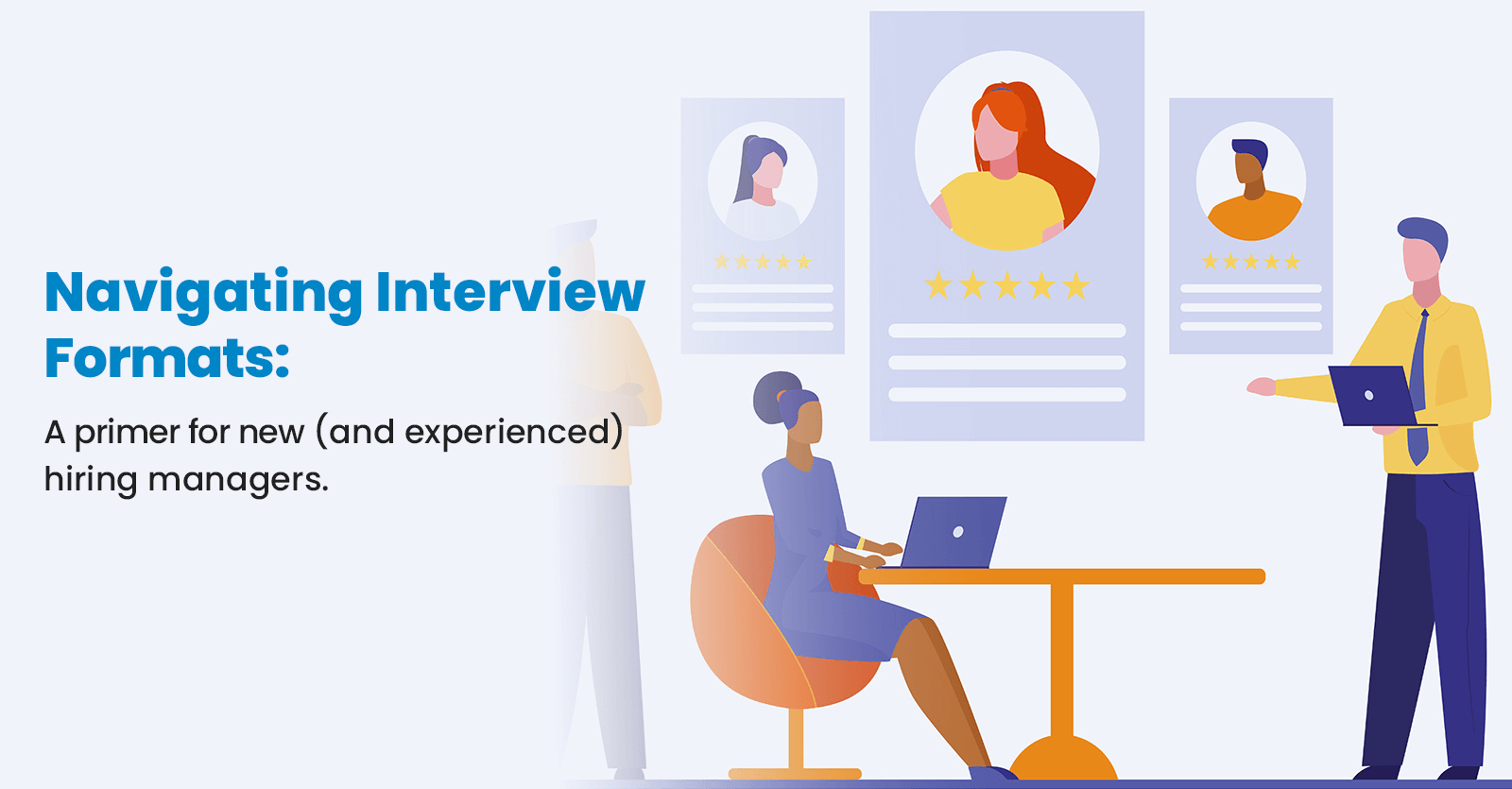Bonjour, je suis ravie de partager avec vous quelques réflexions issues de mon parcours dans le domaine du recrutement. Maîtriser l'art de l'entretien est essentiel pour dénicher les meilleurs talents. Voyons comment le choix du bon format d'entretien peut transformer votre stratégie de recrutement. Le choix du bon format d'entretien est essentiel, car il peut faire toute la différence ...
Choisir le bon format d'entretien est essentiel, car cela peut faire toute la différence pour mener une recherche d'emploi efficace et trouver le candidat idéal pour votre équipe. Qu'il s'agisse d'un génie technique ou d'un leader visionnaire, chaque rôle exige une approche unique.
Un bon processus d'entretien est également un élément important pour créer une bonne première impression sur les candidats que vous recherchez. Chaque détail de la procédure d'entretien - depuis la prise de rendez-vous jusqu'à l'arrivée du candidat et à la conversation elle-même - fait partie de votre image de marque et aura un impact sur l'intérêt qu'il aura à travailler pour vous. Sans vouloir vous accabler, tous les petits détails ont leur importance.
Commençons par les formats d'entretien les plus populaires et la manière dont ils peuvent pimenter votre processus d'embauche.

1. Entretiens individuels
Ah, l'entretien individuel classique ! Toute l'énergie et l'excitation de rencontrer quelqu'un pour la première fois et d'apprendre à connaître ses compétences, ses expériences et à savoir s'il s'intègre bien à la culture de votre équipe.
Ces entretiens sont parfaits pour une première sélection et peuvent être approfondis pour évaluer les compétences techniques, le style de travail et l'expérience professionnelle. [Par exemple, lorsque j'ai recruté un graphiste, un entretien individuel m'a permis de comprendre la créativité et le processus de réflexion du candidat].
Les entretiens individuels sont les meilleurs en raison de leur simplicité et de leur efficacité. Ils sont plus faciles à préparer et offrent plus d'espace aux deux parties pour établir une relation, ce qui peut aider à évaluer l'adéquation culturelle et les qualités personnelles.
L'inconvénient est que la conduite d'un entretien unique de qualité nécessite de la préparation, de l'expérience et de la formation - toute faiblesse dans les capacités de l'intervieweur aura pour conséquence de laisser passer un excellent candidat. De plus, par définition, ils reposent uniquement sur le jugement d'un seul intervieweur, ce qui peut entraîner un risque de partialité inconsciente ou de perspective limitée.

"Planifier l'entretien 1:1. Je vise généralement un entretien d'une heure, dont 80% sont consacrées à mes questions et 20% aux questions du candidat.
2. Entretiens avec les panels
Imaginez un candidat entouré d'une équipe d'examinateurs issus de différents services. C'est comme un concours de talents où chaque examinateur apporte un point de vue unique. Ce format est idéal pour les fonctions qui interagissent avec plusieurs équipes [Pensez à l'embauche d'un chef de projet - vous aurez besoin de l'avis des techniciens, des commerciaux et des opérationnels pour avoir une vue d'ensemble de la situation, ndlr].
Mais n'oubliez pas que trop de cuisiniers (ou d'intervieweurs) peuvent gâcher le bouillon ! Il est essentiel de rester organisé pour éviter de submerger le candidat.
Les entretiens avec un panel peuvent s'avérer très utiles parce qu'ils font appel à la perspicacité collective du panel. Les intervieweurs peuvent tirer parti de leur propre expérience pour se concentrer sur différents aspects du potentiel du candidat. C'est également un excellent moyen de soutenir un intervieweur moins expérimenté qui pourrait être débordé lors d'un seul entretien.
À l'inverse, les entretiens avec un panel peuvent être intimidants et il est difficile d'établir une relation avec le candidat. Cela peut conduire à des performances décevantes qui vous amènent à ne pas reconnaître le talent d'un candidat. Les panels exercent également une forte pression sur les membres pour qu'ils travaillent ensemble et coordonnent leurs questions. Il est incroyablement facile de s'écarter du sujet, de mal gérer son temps ou d'être généralement désorganisé. Sans oublier que la rapidité est souvent importante dans un processus de recrutement, afin qu'un excellent candidat ne soit pas perdu au profit d'une offre concurrente. La coordination des calendriers avec plusieurs entretiens peut ralentir le processus d'embauche.

3. Observation au poste de travail
L'observation au poste de travail est un test pour les deux parties. Les candidats ont un véritable aperçu du travail et vous les voyez à l'œuvre. J'ai constaté que cette méthode était utilisée efficacement dans un large éventail de fonctions, allant des postes de développeurs spécialisés aux équipes administratives, en passant par les recruteurs. Dans la version de base, le candidat potentiel est associé à un employé actuel et observe son travail pendant une partie de la journée.
La plupart des situations s'en tiennent à une véritable observation passive, mais j'ai travaillé pour une grande entreprise de commerce électronique qui aimait faire participer les candidats à des scénarios de programmation en binôme pour voir comment ils se débrouillaient dans un problème pratique.
L'observation au poste de travail est formidable car elle donne aux deux parties une expérience très précise de ce à quoi s'attendre. L’inconvénient de l’observation est qu’il s’agit d’une demande importante pour les candidats et qu’elle peut perturber votre lieu de travail. Cela soulève également des problèmes de confidentialité, en particulier sur les lieux de travail où des informations personnelles sensibles sont présentes. Enfin, de nombreuses juridictions considèrent les exercices d’observation au poste de travail comme du travail non rémunéré et ont pris des mesures pour les interdire explicitement. de shadowing is that it is a big ask for candidates and can be disruptive to your workplace. It also raises confidentiality concerns, especially workplaces where sensitive personal information is present. Finally, many jurisdictions view job shadowing exercises as unpaid work and have taken steps to explicitly prohibit it.
4. Études de cas
C'est là que les choses deviennent intéressantes. Présentez un défi à un candidat et observez sa capacité à résoudre les problèmes. Les études de cas sont idéales pour les postes qui requièrent un esprit critique et des compétences en matière de résolution de problèmes. Imaginez que vous recrutiez un directeur marketing : une étude de cas bien conçue sur une campagne de lancement d'une nouvelle marque peut en dire long sur son approche et son style de travail.
L'inconvénient est que le dossier a beaucoup d'importance. Un cas mal rédigé ou une mauvaise animation peut gâcher l'expérience du candidat et ne fournir que peu d'informations pour étayer votre décision d'embauche. En outre, les entretiens basés sur des études de cas peuvent être stressants pour certaines personnes et vous faire manquer un candidat par ailleurs talentueux.
Faites également très attention aux préjugés - il est facile de se retrouver à "diriger le témoin" dans une conversation de cas, ce qui entraînera un processus d'évaluation déséquilibré. Veillez à disposer d'un tableau de bord objectif pour votre étude de cas, qui soit lié aux exigences réelles du poste. Là encore, vous devez éviter de donner l'impression de solliciter un travail non rémunéré.

5. Entretiens de groupe
Les entretiens de groupe impliquent plusieurs candidats simultanément et peuvent s'apparenter à une mini émission de télé-réalité. Vous pouvez voir comment les candidats interagissent au sein d'une équipe - qui prend les devants, qui collabore bien, etc.
Les entretiens de groupe vous permettent d'examiner plusieurs candidats à la fois, ce qui en fait une méthode efficace pour les postes nécessitant plusieurs recrutements. Ils permettent également de savoir comment les candidats gèrent la dynamique de groupe, la concurrence et les interactions avec leurs pairs, ce qui peut s'avérer très utile pour les candidats débutants qui n'ont pas d'antécédents professionnels importants.
Si vous utilisez cette approche, faites attention aux dynamiques interpersonnelles. Les personnes timides risquent d'être éclipsées par les personnes plus franches. Il s'agit de savoir ce dont le poste a besoin.
6. Entretiens techniques ou axés sur les compétences
Vous avez une compétence spécifique à tester ? Lancez l'entretien technique. Il s'agit de voir les candidats en action, en train de faire ce qu'ils font le mieux. Pour nos postes de développeurs de logiciels internes, notre équipe consacre la majeure partie de son temps à une série d'exigences et de défis de codage.
Il est important d'élaborer un script d'entretien qui soit plus qu'un simple contrôle de connaissances - il vous permet d'évaluer les compétences générales du candidat dans un domaine donné et son approche globale du travail. Trop souvent, j'ai vu des intervieweurs très brillants se concentrer sur la meilleure réponse unique, alors que la réalité est plus compliquée. Pour de nombreux types de travail, il peut y avoir plusieurs bonnes réponses en fonction des objectifs, des hypothèses, du contexte et de l'expérience - autant d'éléments qu'il est difficile de contrôler dans le cadre d'un entretien.
Le filtrage technique est également très rétrospectif - c'est-à-dire qu'il s'agit de savoir ce que vous savez à l'heure actuelle. Elle ne permet pas de prendre en compte le potentiel ou les performances futures. Par conséquent, il est important de laisser de la place pour évaluer la curiosité et le potentiel de croissance (aucun de ces éléments n'apparaîtra dans un test traditionnel). Une chose est sûre : les compétences techniques qui leur ont permis d'arriver jusqu'à aujourd'hui ne resteront probablement pas utiles à l'avenir.
7. Entretiens comportementaux
Les entretiens comportementaux s'apparentent à un travail de détective : ils permettent de découvrir comment les candidats ont agi dans des situations antérieures afin de connaître leur style de travail et leur approche des problèmes. Ils sont très utiles pour comprendre comment une personne pourrait s'intégrer dans votre équipe et relever les défis futurs.
Le format général d'une question d'entretien portant sur le comportement est le suivant : "Parlez-moi d'une fois où vous avez vécu une expérience X. Que s'est-il passé et comment l'avez-vous géré ? Dans la réponse du candidat, vous cherchez à comprendre le problème, le rôle du candidat dans sa résolution et le résultat qu'il a obtenu.
Les questions sur le comportement ne visent pas à obtenir une réponse exacte, mais à vous donner une idée de leur style de travail et de la manière dont ils réagissent dans une situation donnée. Comment a-t-il abordé le problème - directement ou indirectement ? Comment a-t-il défini le résultat - orienté vers les résultats, orienté vers l'équipe ou les deux ? Sa réponse est-elle spécifique et ancrée dans des résultats mesurables, ou plutôt de haut niveau et relationnelle ?
La plus grande erreur commise par les intervieweurs est de permettre aux candidats de donner des réponses de haut niveau et de ne pas creuser dans les détails. Soyez prêt à creuser et à poser de nombreuses questions complémentaires. Veillez également à noter tous les points intéressants afin d'en assurer le suivi lors de l'étape des références.

L'impact de la technologie sur les entretiens
La technologie a un impact considérable sur le processus d'entretien et sur tous les aspects de la sélection des candidats. L'adoption de l'entretien vidéo a constitué à elle seule un changement majeur qui a permis aux managers d'accéder à de nouveaux types de candidats, mais qui a également donné lieu à une variété de nouveaux systèmes de tricherie lors des entretiens, allant des candidats de remplacement, à l'aide hors caméra, ou même à une aide plus avancée aux réponses en temps réel, pilotée par le système GPT.
Du côté des recruteurs, nous observons un flux régulier de nouveaux outils, allant des plateformes d'entretiens asynchrones enregistrés aux premiers concepts d'IA qui prétendent offrir une analyse significative de la voix et du langage corporel.
Je m'attends à ce que cette partie du processus de recrutement continue d'évoluer de manière spectaculaire au cours des prochaines années, à mesure que les implications des entretiens à distance et l'intégration des services d'intelligence artificielle continueront de proliférer.
La technologie ne remplacera cependant pas le problème principal : les responsables du recrutement sont toujours à la recherche de la personne idéale pour leur équipe et utilisent une variété de techniques pour sélectionner les candidats et prendre une décision d'embauche. Les gestionnaires de recrutement compétents devront continuer à affiner leurs compétences, sous peine de commettre des erreurs d'embauche coûteuses.

Un petit mot sur la diversité et l'inclusion
C'est vraiment un sujet à part entière. En bref, la réflexion sur la diversité et l'inclusion est un élément essentiel de la phase d'entretien. Elle est essentielle pour créer une main-d'œuvre qui reflète un large éventail de perspectives et d'expériences.
La meilleure pratique consiste à n'utiliser que des entretiens structurés, c'est-à-dire un scénario d'entretien écrit dans lequel tous les candidats se voient poser les mêmes questions et sont évalués sur la base d'un tableau de bord commun. Cette cohérence permet de réduire l'influence des préjugés inconscients. Cette pratique est suivie de près par une formation efficace des intervieweurs, axée sur l'IED, et par l'utilisation, dans la mesure du possible, d'équipes d'intervieweurs diversifiées.

Faire le bon choix en matière de format d'entretien
Au fond, l'entretien consiste à se renseigner sur les candidats, à évaluer leur adéquation au poste et à se forger une conviction sur la personne qui, selon vous, sera le meilleur membre de votre équipe.
Les entretiens jouent un rôle essentiel dans le processus d'évaluation, et il est important d'utiliser le bon type d'entretien en fonction de votre poste, de vos compétences et de vos objectifs de recrutement. Chaque format, qu'il s'agisse d'entretiens individuels, de discussions de groupe, d'observation, d'études de cas, d'entretiens de groupe, d'évaluations techniques ou de questions comportementales, a un objectif spécifique et offre un aperçu unique de l'aptitude d'un candidat à occuper un poste.
Un bon processus d'entretien sera attrayant pour les candidats et vous permettra d'en savoir plus sur eux, de les comparer et d'être convaincu que vous avez trouvé la bonne personne.
Boîte à outils pour l'amélioration des compétences en matière d'entretien
En tant que recruteur, il est essentiel d'améliorer vos compétences en matière d'entretien. Envisagez de lire "The Manager's Book of Questions" de John Kador pour obtenir une liste complète de questions d'entretien. Participez à des cours en ligne sur LinkedIn Learning ou Coursera qui se concentrent sur le perfectionnement des techniques d'entretien. En outre, la participation à des séminaires ou à des ateliers sur la diversité et les préjugés inconscients est inestimable pour mener des entretiens équitables et inclusifs. En restant au fait des meilleures pratiques les plus récentes en matière d'entretien, vous améliorerez considérablement vos stratégies de recrutement et leurs résultats... et vous éviterez le nombre croissant d'écueils coûteux liés à l'utilisation de techniques de sélection obsolètes.

Avec plus de vingt ans d'expérience dans le secteur technologique, Kent est spécialisé dans la conduite d'initiatives commerciales et technologiques, tant au sein de Procom que pour le compte de ses clients. Il a constitué des équipes, dirigé des projets et mené à bien des initiatives critiques de transformation de l'entreprise.






